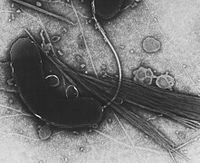
Photo from wikipedia
Symbioses are significant drivers of insect evolutionary ecology. Despite recent findings that these associations can emerge from environmentally derived bacterial precursors, there is still little information on how these potential… Click to show full abstract
Symbioses are significant drivers of insect evolutionary ecology. Despite recent findings that these associations can emerge from environmentally derived bacterial precursors, there is still little information on how these potential progenitors of insect symbionts circulate in trophic systems. Serratia symbiotica represents a valuable model for deciphering evolutionary scenarios of bacterial acquisition by insects, as its diversity includes gut-associated strains that retained the ability to live independently of their hosts, representing a potential reservoir for symbioses emergence. Here, we conducted a field study to examine the distribution and diversity of S. symbiotica found in aphid populations, and in different compartments of their surrounding environment. Twenty % of aphids colonies were infected with S. symbiotica, including a wide diversity of strains with varied tissue tropism corresponding to different lifestyle. We also showed that the prevalence of S. symbiotica is influenced by seasonal temperatures. We found that S. symbiotica was present in non-aphid species and in host plants, and that its prevalence in these samples was higher when associated aphid colonies were infected. Furthermore, phylogenetic analyses suggest the existence of horizontal transfers between the different trophic levels. These results provide a new picture of the pervasiveness of an insect symbiont in nature.
Journal Title: FEMS microbiology ecology
Year Published: 2022
Link to full text (if available)
Share on Social Media: Sign Up to like & get
recommendations!